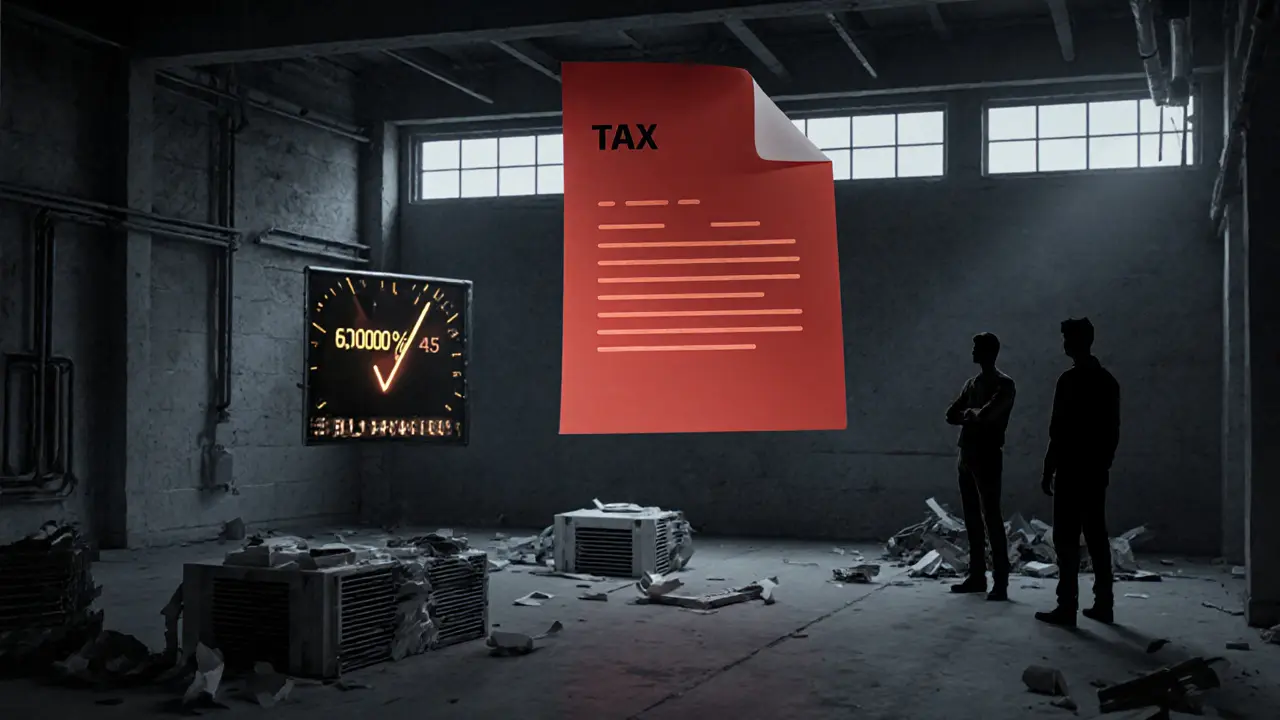Sweden Cracks Down on Crypto Mining: Tax Incentives Gone
 Oct, 14 2025
Oct, 14 2025
Crypto Mining Profitability Calculator
Sweden Tax Impact Calculator
Important: Sweden's energy tax increased from SEK 0.006 to SEK 0.36 per kWh (6,000% increase) effective July 2023.
When Sweden's cryptocurrency mining tax policy came under fire for its drastic reversal, the entire European mining landscape felt the tremor, operators suddenly faced a fiscal cliff. The move wiped out a generous 98% tax break that had drawn miners to the country’s cool climate and cheap hydro power, then added a punitive energy levy that made mining virtually unprofitable. If you’ve been tracking crypto news this year, you’ve probably wondered how such a sudden shift could happen and what it means for miners, investors, and regulators. Below you’ll find a step‑by‑step look at the policy, the numbers, and the fallout.
Why Sweden Was a Mining Magnet in the First Place
Back in 2017, Sweden introduced a 98% tax reduction for data‑center‑type facilities. The incentive was originally aimed at cloud providers and AI labs, but crypto miners quickly caught on. The country offered three key advantages:
- Abundant hydroelectric power generated by rivers in the north, delivering low‑cost, carbon‑light electricity.
- A naturally cool climate that reduced cooling costs for massive ASIC rigs.
- A stable regulatory environment that, at the time, seemed welcoming to digital‑asset businesses.
By 2022, the country hosted roughly 150MW of dedicated mining capacity, a figure that made it the last stronghold for European Bitcoin miners according to industry trackers.
The Policy U‑Turn: What Changed and When
In November 2022, Sweden’s budget announced a radical shift. Effective July 2023, the government did two things:
- Removed the 98% tax reduction entirely.
- Raised the energy tax for data‑center‑type loads from SEK0.006 to SEK0.36 per kilowatt‑hour, a 6,000% jump.
In plain English, miners went from paying pennies per kWh to roughly $0.035, a cost that dwarfs any revenue from most coins unless prices surge dramatically.
The legislation cited two main concerns:
- Minimal contribution to local employment and economic activity.
- Disproportionate energy consumption relative to public benefit.
Swedish officials also referenced the 2018 crypto crash, where abandoned mining farms left unpaid electricity bills and strained the grid.

Crunching the Numbers: Tax Impact in Detail
| Metric | Before July2023 | After July2023 |
|---|---|---|
| Tax reduction on data‑center electricity | 98% reduction | No reduction (full rates apply) |
| Energy tax per kWh | SEK0.006 (~$0.0006) | SEK0.36 (~$0.035) |
| Effective cost increase | - | ≈6,000% |
| Active mining capacity (MW) | ≈150MW | ≈5‑10MW (post‑shutdown) |
To put the jump in perspective, a 1TH/s ASIC rig that consumed 3kW would see its electricity bill rise from roughly $200 a month to $11,500 a month, wiping out any profit unless Bitcoin prices spiked by more than 800%.
Impact on Miners: From Stranded Assets to Relocation
Operators scrambled. Some chose to liquidate hardware locally at a loss; others booked expensive freight to move rigs to friendlier jurisdictions. The most common destinations?
- Kazakhstan - low electricity rates but higher political risk.
- U.S. states like Texas and Wyoming - abundant cheap wind and solar power.
- Canadian provinces such as Quebec and Alberta - still offer attractive hydro and natural‑gas tariffs.
Industry interviews revealed that a typical miner needed at least three months to dismantle a facility, arrange shipping, and secure new grid connections. The rapid policy rollout left many with “stranded assets”: purpose‑built bunkers, cooling systems, and high‑density power infrastructure that suddenly had no economic use.Community chatter on Reddit’s r/BitcoinMining crackled with frustration. One user summed it up: “Sweden just made mining impossible overnight. We’re packing up and heading west.”
How Sweden’s Approach Differs from Its Neighbours
Norway, Sweden’s fellow Nordic powerhouse, has also expressed concerns about mining’s energy draw, but it stopped short of punitive taxes. Instead, Norway focuses on voluntary carbon‑offset programs and encourages miners to use excess renewable capacity during off‑peak hours.
Contrast that with El Salvador, which actively subsidizes Bitcoin mining by offering cheap geothermal energy, or Texas, where the state government bills itself as a “crypto‑friendly haven” and even launched a mining‑focused utility rate plan.
The Swedish model stands out because its tax hike is not a modest surcharge-it’s a 6,000% increase that dwarfs any comparable levy in the EU. No other member state has yet introduced a similar punitive scheme, making Sweden a potential test case for governments that want to “tax out” unwanted industry activity.

What the Policy Means for the Broader Crypto Ecosystem
From an investor’s viewpoint, the Swedish crackdown removed a key source of relatively low‑cost hash power that helped keep Bitcoin’s network hashrate diversified across regions. The immediate effect was a temporary dip in global hashrate, followed by a quick rebound as miners migrated east and south.
Regulators elsewhere are watching closely. The European Union is drafting a “Digital Services Act”‑type framework that could include environmental caps on mining. Sweden’s hard‑line stance provides a data point: heavy taxation can indeed force an industry out, but it also raises questions about capital flight and the loss of potential tech‑jobs that could have been created with a more balanced approach.
For miners still weighing where to set up shop, a simple rule of thumb has emerged: calculate the total cost of electricity per kilowatt‑hour (including taxes) and compare it to the projected revenue per megahash. If the break‑even price exceeds the current market price by more than 30%, the operation is unlikely to survive long‑term.
Looking Ahead: Will Sweden Keep Its Hard Stance?
As of late 2023, commercial mining in Sweden is effectively dead. The government’s stated goal-to deter mining that offers “minimal economic benefit”-has been achieved. Yet political winds can change. A new coalition could revisit the policy if a future energy surplus makes cheap power widely available again.
In the meantime, the Swedish case is being cited in policy workshops across Brussels, Stockholm, and Berlin as a cautionary tale of using tax law as a blunt instrument. Academics argue that a more nuanced approach-like a carbon‑price floor combined with a modest energy surcharge-might achieve environmental goals without prompting a full industry exodus.
For now, the lesson is clear: governments can wield tax policy to shape the geography of crypto mining, and miners must stay agile enough to relocate at a moment’s notice.
Frequently Asked Questions
What exactly did Sweden change in its tax code?
Sweden eliminated the 98% tax reduction for data‑center electricity and raised the energy tax from SEK0.006 to SEK0.36 perkWh, a 6,000% increase that applies to all high‑consumption facilities, including cryptocurrency miners.
Why did the government target crypto miners specifically?
Officials argued that mining contributed little to local employment and strained the power grid without delivering proportional economic benefits, especially after the 2018 market crash left unpaid electricity bills.
How does the new tax compare to other European countries?
Sweden’s 6,000% hike far exceeds any EU counterpart. Norway imposes no extra mining tax; Germany and France focus on energy‑efficiency regulations rather than direct fiscal penalties.
What are the main destinations for relocated Swedish miners?
Most have moved to Kazakhstan, Texas, Wyoming, and Canadian provinces like Quebec, where electricity remains cheap and regulatory frameworks are friendlier.
Will the policy affect non‑crypto data centers?
Yes. The energy tax applies to any high‑consumption facility, so cloud providers and AI labs now face higher electricity costs as well.


Kyla MacLaren
October 14, 2025 AT 09:32That tax jump is a real bummer for miners.